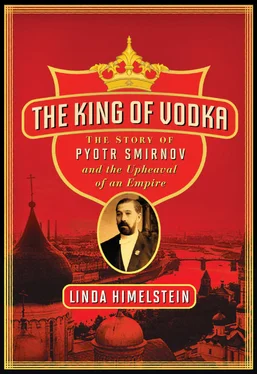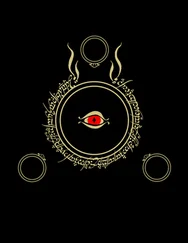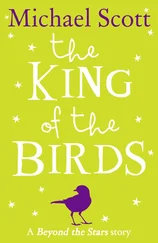20. S. Muravyov and F. Pogodin, “Borisa na tsarstvo,” Vlast 2 (161), Jan. 30, 1996, http://www.kommersant.ru/doc.aspx?DocsID=11970.
21. “Diageo and A-1, an Alfa Group company, create strategic partnership for expansion in Russia,” Diageo press release, Feb. 27, 2006.
22. Russian Statistical Annual, 2007. http://www.gks.ru/bgd/regl/B07_13/IssWWW.exe/Stg/d01/04-27.htm.
Little independent or primary evidence exists detailing Smirnov’s early childhood. This reconstruction is drawn from available data on serfs and information provided by Vladimir Grechukhin, the director of the Folk Ethnographic Museum in Myshkin, which houses a small museum devoted to Smirnov.
Mariya’s age is calculated by church records at the time of her death. No birth records for her could be found.
Details of Smirnov’s village life are drawn from regional museums and archives with the help of Vladimir Grechukhin. They reflect the most pervasive local customs at the time.
The value of a ruble in 1821 was about twenty-one cents.
Grigoriy’s business history is culled from pages in the Uglich government archives.
A local listing of businesses confirms that Arseniy came to Uglich to work with Grigoriy. It is presumed that Pyotr and his brother did as well since boys typically stayed with their fathers.
The timing of Ivan’s arrival in Moscow is derived from his death notice.
The journey to Moscow has been re-created from available records and from typical stories of serfs going to Moscow for seasonal work.
The modern address is given here. It was different in the nineteenth century.
Boyar is an old term referring to a member of the Russian aristocracy.
Pubs, taverns, wine cellars, and other liquor outlets had to follow strict rules. Taverns, for instance, were allowed to serve food along with liquor to customers while many wine cellars could not. Some shops could serve only take-out drinks while others were allowed to serve drinks on their premises.
This is a reconstruction based on the available evidence.
The dialogue and scene have been created to demonstrate a typical exchange during Smirnov’ time.
$1.30 in 1858 ($36 today).
About $46,768 today.
Dukhobors were a religious sect that did not accept churches as places for prayer. They were supported by Tolstoy at the end of the nineteenth century. Molokans were a religious sect opposed to the Russian Orthodox Church and its rituals.
Serfs still faced difficulty leaving their villages and often could not afford to buy land offered them because of steep costs.
Russia uses a different way of measuring alcohol content than the United States. Degrees and percents are equivalent, but an alcohol’s proof value is different.
Smirnov’s name never appears in attendance records of these events or in the memoirs of other merchants at the time.
The average cost of a bottle of wine was calculated from retail prices listed by participants in the Russian Exhibition of 1870.
Evidence regarding Smirnov’s preparations for, and the journey to, the fair is scarce. This account is a likely scenario based on available archives, documents, and family accounts.
The anecdote comes from a translation of Vladimir Smirnov’s memories in the Bakhmeteff Archive at Columbia University, New York City.
The conclusion about the change in commercial advertisements comes from an analysis of six leading newspapers in Moscow.
In Russia, vodka was referred to as wine.
The ad and its translation were obtained from the Smirnoff Vodka Archive collection at the Davis Center for Russian Studies in the Fung Library at Harvard University.
In reality, the law encouraged more producers to enter the business illegally. They did not want to pay higher fees and therefore launched their operations outside the law.
Pubs were places where only drinks could be served.
Smirnov’s interior design plans come from floor plans obtained from the Moscow Committee on Heritage.
Anecdote provided by Anton Valdin, a genealogist who worked with Smirnov’s descendants. The anecdote also appears in The Vodka King , a book published in 1999 that was written by Smirnov’s descendants.
Prior to Smirnov’s request, the title of vodka purveyor to the tsar could be held only by an individual.
Kira Smirnova related this story during interviews in Moscow in July 2005 and in October 2007.
The equivalent of about $5 billion today.
Description is based on a personal interview on Nov. 12, 2005, with Varvara Nikolayevna Petukhova, a resident who saw the cathedral. It no longer exists.
The five sons and Mariya were each left 260,000 rubles in cash. After Mariya’s death, her share was, as far as anyone knows, divided equally among the sons.
This information comes from extensive research conducted by Sergey’s son Oleg in the 1970s.
The 500,000 rubles payment is an assumption based on the amount Vladimir officially received for his interest in the family business, though it could have been more. In addition, the agreement was changed in April 1905 to cover eight years.
Based on the memoirs of P. Isheyev, a close friend of the couple.
Documents explaining the aftermath of these decisions could not be located. It is likely the Smirnovs appealed the decisions. Company ads from 1914 to 1917 feature all four coats of arms and reference to the purveyor title.
The Smirnov’s wartime contributions come from research conducted by Anton Valdin.
Remains of all but two victims were discovered in 1991. The last two, including Nikolay II’s only son, Aleksey, were found in 2007.
During Stalin’s reign these paintings were hidden because Stalin saw them as decadent. Only after his death, in the 1950s, did they begin to be viewed publicly.
During the height of the Cold War, the popularity of the Moscow Mule waned. However, in the summer of 2008, Diageo, the largest spirits company in the world, reintroduced the classic cocktail through a multimillion-dollar advertising campaign.
Interview with Anton Valdin.
Translated archival documents obtained from the Davis Center for Russian Studies, the Smirnoff Vodka Archives Collection in the Fung Library, Harvard University.












